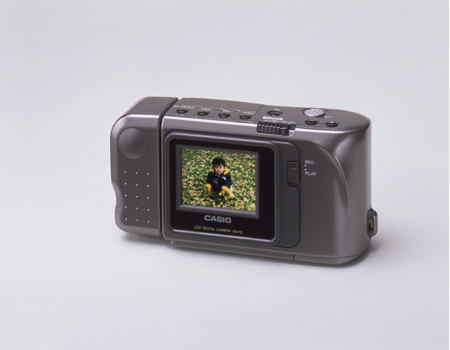Casio QV-10 LCD Digital Camera Registered as an Essential Historical Material for Science and Technology by Japan’s National Museum of Nature and Science

TOKYO, September 13, Casio Computer Co., Ltd. announced today that the Casio QV-10 digital camera, originally released by Casio in 1995, has been registered as a 2012 Essential Historical Material for Science and Technology by Japan’s National Museum of Nature and Science. The QV-10 was the world's first* consumer-grade LCD digital camera. The registration recognizes the QV-10’s contribution to the rise in popularity of digital cameras.
*. As a consumer-grade digital camera equipped with an LCD and weighing less than 280 grams.
The Essential Historical Material for Science and Technology is a registration system launched in 2008 by the National Museum of Nature and Science under the leadership of Director General Shinji Kondo to retain and utilize scientific and technological materials that have made a significant contribution to the advancement of science and technology, and, as such, possess significant meaning that should be passed onto the next generation, and, furthermore, that have made a remarkable impact on lifestyle, economy, society and culture.
The QV-10 that is being registered as an Essential Historical Material for Science and Technology this year was a compact digital camera equipped with a color TFT LCD monitor that enabled users to directly confirm the photos they had taken.
It was light and mobile enough to take anywhere. Since users could check photos right away, it was easy enough to delete mistakes and store the photos they liked on their PCs. Furthermore, its price tag was a mere 65,000 yen, which at the time was virtually inconceivable. The QV-10 went on to become a huge hit product.
Until the QV-10 came along, digital cameras were very expensive devices used mainly by news organizations and other media outlets. The QV-10 became very popular, changing the world of cameras to the extent that the word “camera” itself now, by and large, means digital camera, not film camera. In recognition of this contribution, the QV-10 was registered as a 2012 Essential Historical Material for Science and Technology.
Furthermore, the registration of the QV-10 marks the third time that Casio has received this honor, following the CASIO-MINI electronic calculator in 2008 and the DC-90 digital camera prototype (nicknamed Ms. Atsuko and Ms. Omoko) in 2009.
Japan’s National Museum of Nature and Science
Founded in 1877, the National Museum of Nature and Science boasts one of the richest histories of any museum in Japan. It is Japan’s only nationally administered comprehensive science museum, and is a central institute for research in natural history and history of science and technology. It also serves as a guardian of a valuable collection of over 4 million specimens. Utilizing collections and research results, the Museum presents many exhibitions. In fiscal 2011, it welcomed over 1.8 million visitors at the Ueno District, Tsukuba Botanical Garden and Institute for Nature Study.
